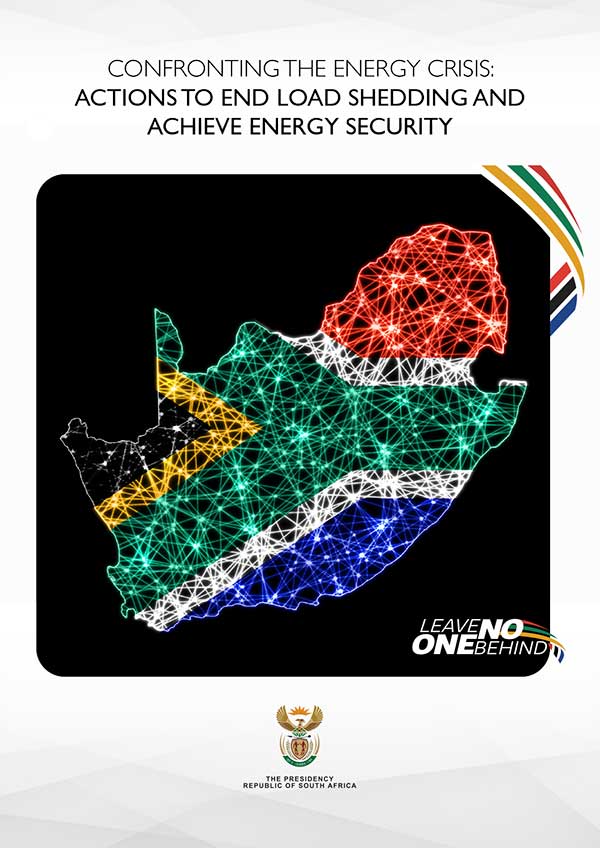Just transition to a low-carbon economy
Energy security is the backbone of the economy, driving economic growth and transformation. We have taken action to rapidly and substantially expand energy generation capacity in addition to what Eskom generates. These energy reforms will reduce pressure on the national grid and lower the risk of power cuts.
Properly managed, the energy transition will benefit all.
Renewable energy production will make electricity cheaper and more dependable, and will allow our industries to remain globally competitive.
Investments in electric vehicles and hydrogen will equip South Africa to meet the global clean energy future.
We will be able to expand our mining industry in strategic minerals that are crucial for clean energy, like platinum, vanadium, cobalt, copper, manganese and lithium.
We also have a unique opportunity in green hydrogen, given our world-class solar and wind resources and local technology and expertise.
Find out more about what government is doing to fix Eskom and transform the electricity sector to achieve long-term energy security.
CLICK HERE TO DOWNLOADEnergy generation projects coming online
5 700 MW
From renewable energy programme
Up to 800 MW
From risk mitigation projects
4 000 MW
Embedded energy from mining sector
3 000 MW
Gas
500 MW
Battery storage
Fixing Eskom
Restructuring
Eskom’s restructuring has laid the foundations for an efficient, modern and competitive energy system. The power utility has been restructured into three separate entities for generation, transmission and distribution, each with its own boards and managing directors. We are working closely with Eskom to improve its financial position, manage its debt, reduce its dependence on the fiscus and ensure its financial sustainability.
Eskom is:
- Executing its Generation Recovery Plan to increase plant performance and reduce unplanned plant breakdowns
- Making substantial progress with its intensive maintenance and operational excellence programmes to improve the reliability of its coal fleet
- Working to fast-track its commercial and technical processes to allow additional capacity onto the grid without undue delay
The independent transmission company, established under Eskom, is on track to separate its generation and distribution businesses by the end of 2022. This will radically transform the structure of the electricity sector for future generations.
Repurposing
Eskom is looking at repurposing its old coal-fired power plants into renewable energy plants. The Komati power station in Mpumalanga is set to shut down by 2022, and has been earmarked for repurposing. This will be the pilot project for the conversion of a number of other facilities. Once repurposed, Eskom will test the plant’s grid performance as well as review opportunities for the Komati community who will be affected by the switch from coal to renewables.
We have made land available next to Eskom power stations in Mpumalanga for renewable energy projects, which will unlock 1 800 MW of new capacity.
Eskom will also partner with investors to repurpose and repower part of its coal fleet. This will be done in a way that stimulates investment, local economic activity and local manufacturing as part of a just transition.
Just transition
Eskom’s green energy transition plan is a first step to decarbonise the energy sector. This involves shifting from generating electricity through fossil fuels to clean energy from renewables. The strategy will also accelerate the repurposing and repowering of power stations to grow renewable energy.
Eskom is planning to develop 8 017 MW of renewable energy projects, ranging from wind power to solar, hydropower and gas. This transition to green energy will cost about R146 billion.
Proposed projects for the Green Energy Transition plan
1 566.2 MW
Solar power
600 MW
Wind power
4 000 MW
Gas
61 MW
Battery storage
1 400 MW
Micro-grids
390 MW
Pumped storage
Independent power producers
The Independent Power Producer (IPP) Procurement Programme is contributing to energy security through the procurement of significant renewable energy and non-renewable generation capacity from the private sector. The programme has also been structured to contribute to the broader national development objectives of job creation, social upliftment and broadening of economic ownership. The programme is already delivering a secure energy supply from a diverse range of energy sources.
The licensing threshold for new embedded generation projects was increased from 1 MW to 100 MW in 2021 and removed completely in 2022. This enables private generators to produce and sell electricity to one or more customers, such as factories, mines or data centres. To date, this has unlocked a pipeline of more than 80 confirmed private sector projects with a combined capacity of over 6 000 MW.
We have changed regulations to enable municipalities in good financial standing to build their own electricity or procure their own power from IPPs.
Independent Power Producer projects
6 304 MW
91 IPPs contracted to deliver
5 823 MW
87 IPPs already delivering
546 MW
From four projects expected to connect in early 2022
Renewable Energy Independent Power Producer Procurement Programme (REIPPPP)
The REIPPPP is aimed at increasing energy generation and supply through private sector investment in wind, biomass and small hydro, among others. The renewables programme has resulted in over 6 000 MW of generation capacity being allocated to bidders across a variety of technologies, principally in wind and solar.
Progress on procurement
1 600 MW already connected to the grid
2 583 MW of new generation capacity in wind and solar by 2024
Additional electricity generation capacity through the fifth, sixth and seventh bid windows is expected to add 6 800 MW of renewable energy to the grid over the medium term – enough to power over 4 million homes.
Government has also embarked on a Gas IPP Programme that will procure up to 3 000 MW of gas with the objective of ensuring grid connection by 2026/27.
Risk Mitigation Independent Power Producer Procurement Programme (RMIPPPP)
The RMIPPPP was introduced to meet the immediate electricity supply gap through procurement from a range of source technologies rather than a specific type. Its second objective is to reduce the extensive use of diesel-based peaking electrical generators in the medium- to long-term. The programme has very tight deadlines to reach commercial operation as soon as possible.
Progress on procurement
Over 1 900 MW procured from IPPs
Will inject private sector investment of R45 billion into the local economy
Expected to produce first power within 18 months of approval
Introducing renewable energy into the power mix
The Redstone Concentrated Solar Power plant is the largest renewable energy project in South Africa.
- R11.6 billion investment
- Will contribute 100 MW of power to the grid
- Will permanently supply 200 000 households with electricity
- Will create 2 000 construction jobs
- Source 44% of its procurement needs from local producers
In addition, the project has committed R1 billion to social-economic and enterprise development.
Climate change
South Africa is committed to a just transition of its energy architecture to achieve net-zero carbon emissions by 2050.
Our goals:
- Increase energy security
- Create millions of new jobs in energy, green hydrogen, electric vehicles and other future-oriented sectors
- Protect jobs in agriculture, tourism and other vulnerable sectors
Eskom, our largest greenhouse gas emitter, has also committed in principle to net-zero emissions by 2050 and to increase its renewable capacity.
Climate change is an existential challenge that confronts us all, and South Africa is committed to playing its part in reducing global emissions.
President Cyril Ramaphosa, SONA 2022
Cutting emissions
At the 2021 United Nations Climate Change Conference (COP26), South Africa committed to ambitious emission reduction targets (compatible with limiting warming to 1.5°C). Achieving these targets requires the transformation of our energy system at an unprecedented speed and scale.
South Africa has led from the front in holding developed countries to their responsibility to finance the transition away from coal. A partnership with the governments of France, Germany, the United Kingdom and the United States, as well as the European Union, represents an important breakthrough in this effort.
Around R131 billion has been secured for the transition to a low-carbon and climate-resilient economy over three to five years, with more funding to be mobilised over the longer term.
This first-of-its-kind partnership will involve repurposing and repowering some of the coal plants that are reaching the end of their lives, and creating new livelihoods for workers and communities most impacted by this change.
In the media
South Africa secures R131-billion in pledges to kick-start energy transition
South Africa has secured R131-billion in pledges over three to five years from the European Union, Germany, France, the UK and the US, who have committed to support the country in its transition to clean, renewable energy.
Mail & Guardian
How is South Africa preparing to navigate a much hotter world? South Africa’s ‘common vision’ to survive in a hotter world.
How does South Africa prepare for a future where surface water resources are ever more scarce, with increasingly frequent multiyear droughts, extended heatwaves and unpredictable rainfall patterns?
Daily Maverick
Climate change Bill to be tabled in parliament
South Africa’s first comprehensive legal framework for climate change will go to committees when parliament reconvenes after the 1 November local government election.
Mail & Guardian
Climate Change Bill
The Climate Change Bill, which provides the legal basis to meet our climate commitments, has been submitted to Parliament. The Bill compels businesses to reduce greenhouse gas emissions that accelerate climate change.
Carbon offsets programme
By end July 2021, a total of 7 364 530 ton C02 equivalent carbon offsets certificates had been retired by carbon taxpayers. This translates to tax savings of just under R1 billion by carbon taxpayers.
The future of energy
Green Hydrogen
South Africa has plans to link its massive platinum reserves to the green hydrogen market, which could be worth $2.5 trillion by 2050.
Over the past year, government has built on its successful Hydrogen SA strategy to make major strides in positioning South Africa as a global leader in this new market. We have developed a Hydrogen Society Roadmap for the next ten years, supporting the development of a green hydrogen pipeline worth around R270 billion.
The project could potentially produce at least 400 kt of hydrogen every year. It also has the potential to create up to 6 000 direct jobs, generating much-needed socioeconomic benefits, including creating further indirect jobs across the ecosystem.
The Platinum Valley Initiative
The Department of Science and Innovation (DSI) has approved a budget of R29.9 million for the Platinum Valley Project. Platinum is a key input in hydrogen fuel cell technology, able to withstand higher temperatures than other metals and a catalyst for generating an electrical current. South Africa has more than 75% of the global reserves of platinum group metals, which places the country in an excellent position.
The project will pull South Africa’s hydrogen initiatives into one integrated hydrogen ecosystem, with the aim of boosting economic growth and job creation, driving the development of new industries and reducing the country's carbon footprint. It will also contribute to energy security in the automotive, materials handling, mining and electrification industries.
The Hydrogen Valley is one of the first projects that will be implemented in partnership with the private sector to support the Platinum Valley initiative. It will be used to establish, accelerate and embed niche innovations through upscaling and replication.
In the media
South Africa eyes future as green hydrogen hub
South Africa has plans to link its massive platinum reserves to the green hydrogen market that is touted as a trillion-dollar opportunity in the green energy world.
African Business
Blade Nzimande launches hydrogen roadmap to a greener future for South Africa
South Africa’s Hydrogen Society Roadmap was released by the Minister of Higher Education, Science and Innovation Dr Blade Nzimande on Thursday.
Daily Maverick



